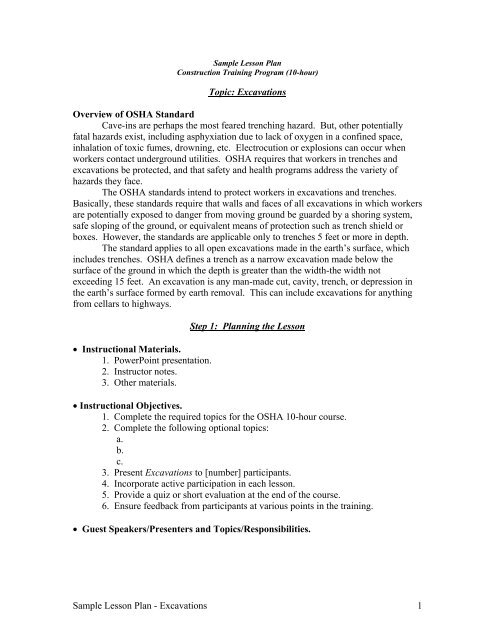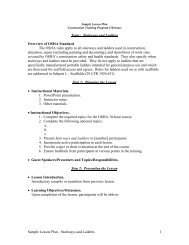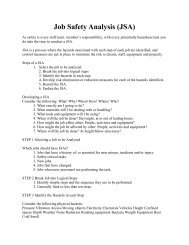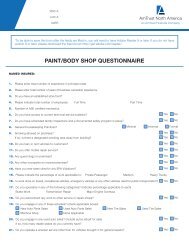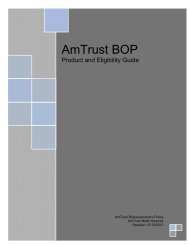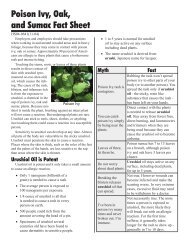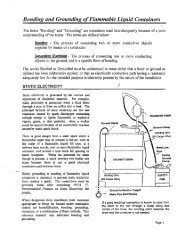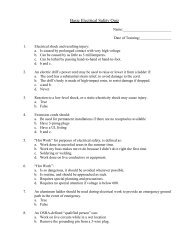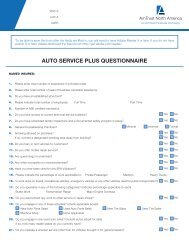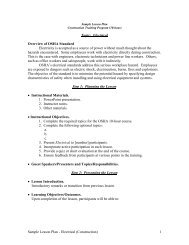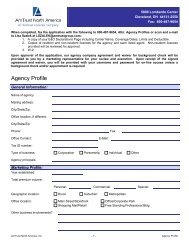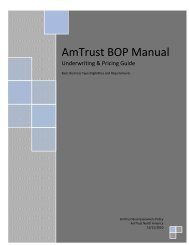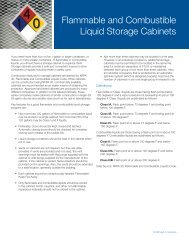Sample Lesson Plan - Excavations 1 Topic: Excavations Overview of ...
Sample Lesson Plan - Excavations 1 Topic: Excavations Overview of ...
Sample Lesson Plan - Excavations 1 Topic: Excavations Overview of ...
You also want an ePaper? Increase the reach of your titles
YUMPU automatically turns print PDFs into web optimized ePapers that Google loves.
<strong>Sample</strong> <strong>Lesson</strong> <strong>Plan</strong><br />
Construction Training Program (10-hour)<br />
<strong>Topic</strong>: <strong>Excavations</strong><br />
<strong>Overview</strong> <strong>of</strong> OSHA Standard<br />
Cave-ins are perhaps the most feared trenching hazard. But, other potentially<br />
fatal hazards exist, including asphyxiation due to lack <strong>of</strong> oxygen in a confined space,<br />
inhalation <strong>of</strong> toxic fumes, drowning, etc. Electrocution or explosions can occur when<br />
workers contact underground utilities. OSHA requires that workers in trenches and<br />
excavations be protected, and that safety and health programs address the variety <strong>of</strong><br />
hazards they face.<br />
The OSHA standards intend to protect workers in excavations and trenches.<br />
Basically, these standards require that walls and faces <strong>of</strong> all excavations in which workers<br />
are potentially exposed to danger from moving ground be guarded by a shoring system,<br />
safe sloping <strong>of</strong> the ground, or equivalent means <strong>of</strong> protection such as trench shield or<br />
boxes. However, the standards are applicable only to trenches 5 feet or more in depth.<br />
The standard applies to all open excavations made in the earth’s surface, which<br />
includes trenches. OSHA defines a trench as a narrow excavation made below the<br />
surface <strong>of</strong> the ground in which the depth is greater than the width-the width not<br />
exceeding 15 feet. An excavation is any man-made cut, cavity, trench, or depression in<br />
the earth’s surface formed by earth removal. This can include excavations for anything<br />
from cellars to highways.<br />
• Instructional Materials.<br />
1. PowerPoint presentation.<br />
2. Instructor notes.<br />
3. Other materials.<br />
Step 1: <strong>Plan</strong>ning the <strong>Lesson</strong><br />
• Instructional Objectives.<br />
1. Complete the required topics for the OSHA 10-hour course.<br />
2. Complete the following optional topics:<br />
a.<br />
b.<br />
c.<br />
3. Present <strong>Excavations</strong> to [number] participants.<br />
4. Incorporate active participation in each lesson.<br />
5. Provide a quiz or short evaluation at the end <strong>of</strong> the course.<br />
6. Ensure feedback from participants at various points in the training.<br />
• Guest Speakers/Presenters and <strong>Topic</strong>s/Responsibilities.<br />
<strong>Sample</strong> <strong>Lesson</strong> <strong>Plan</strong> - <strong>Excavations</strong> 1
Step 2: Presenting the <strong>Lesson</strong><br />
• <strong>Lesson</strong> Introduction.<br />
Introductory remarks or transition from previous lesson.<br />
• Learning Objectives/Outcomes.<br />
Upon completion <strong>of</strong> the lesson, participants will be able to:<br />
1. State the greatest risk that is present at an excavation.<br />
Possible response.<br />
• Cave-ins.<br />
Note: Several other risks exist (drowning, asphyxiation, falling, etc.);<br />
however, the possibility <strong>of</strong> cave-in is present for every excavation, and<br />
impacted by multiple factors.<br />
2. Briefly describe the three main methods for protecting employees from<br />
cave-ins.<br />
Possible responses.<br />
• Sloping. A technique that employs a specific angle <strong>of</strong> incline on the sides <strong>of</strong><br />
the excavation. Angle varies based on assessment <strong>of</strong> impacting site factors.<br />
. • Shielding. A structure able to withstand cave-in and protect employees.<br />
• Shoring. A structure that supports the sides <strong>of</strong> an excavation and protects<br />
against cave-ins.<br />
3. Name at least three factors that pose a hazard to employees working in<br />
excavations, and at least one way to eliminate or reduce each <strong>of</strong> the hazards.<br />
Possible responses.<br />
Potential Hazard<br />
• Cave-in<br />
• Soil Type<br />
• Water<br />
• Vehicles and equipment<br />
• Spoil pile<br />
Potential Solution(s)<br />
• Sloping, shielding or shoring<br />
• Assessment <strong>of</strong> proper protective<br />
system by competent person<br />
• Proper drainage and protective<br />
system<br />
• Barricades, “stop” logs, grade soil<br />
away from excavation, fencing<br />
• Place more than 2 feet from edge<br />
<strong>of</strong> excavation<br />
<strong>Sample</strong> <strong>Lesson</strong> <strong>Plan</strong> - <strong>Excavations</strong> 2
• Learning Objectives/Outcomes. (Continued).<br />
(Possible responses for Objective 3 continued)<br />
Potential Hazard<br />
• Crane operation<br />
• Asphyxiation<br />
• Access/egress<br />
Potential Solution(s)<br />
• Operate as far away from the<br />
edge <strong>of</strong> the excavation as<br />
possible; not closer than two feet<br />
• Ensure testing <strong>of</strong> space by<br />
competent person; emergency<br />
recovery plan in place and<br />
ready to be implemented, if<br />
needed<br />
• Proper design, positioning and<br />
use <strong>of</strong> structural ramps and ladders<br />
4. Describe the role <strong>of</strong> a competent person at an excavation site.<br />
Possible responses.<br />
• Trained and knowledgeable in soil analysis, use <strong>of</strong> protective systems, and<br />
requirements <strong>of</strong> the standard.<br />
• Site evaluation/planning responsibilities:<br />
Í evaluate soil conditions Í select and oversee construction <strong>of</strong><br />
proper protective systems<br />
Í contact utilities for locations<br />
<strong>of</strong> underground lines<br />
Í test for low oxygen and/or<br />
be prepared to test as<br />
excavating proceeds<br />
Í traffic control<br />
Í ensure safe access to/from<br />
and in/out <strong>of</strong> the excavation<br />
Í ensure protection from water<br />
accumulation<br />
• Inspection <strong>of</strong> excavation:<br />
Í inspect site daily, before work starts, after a rainstorm, or during other<br />
inclement weather conditions such as high winds<br />
Í look for evidence <strong>of</strong> potential cave-ins, indication <strong>of</strong> failure <strong>of</strong><br />
protective systems, hazardous atmospheres or other hazardous<br />
conditions<br />
<strong>Sample</strong> <strong>Lesson</strong> <strong>Plan</strong> - <strong>Excavations</strong> 3
• Learning Objectives/Outcomes. (Continued).<br />
(Possible responses for Objective 4 continued)<br />
• remove employees from hazardous areas and ensure employees do not<br />
return until necessary precautions have been taken<br />
• <strong>Plan</strong>ned Activities, Discussion, or Participant Interaction<br />
Step 3: Evaluating Student Learning and Instruction<br />
• <strong>Lesson</strong> Evaluation and Comments.<br />
.<br />
References<br />
OSHA Standard: 29 CFR 1926 Subpart P (1926.650 to 1926.652)<br />
‣ www.osha-slc.gov/OshStd_toc/OSHA_Std_toc_1926_SUBPART_P.html<br />
OSHA Publications<br />
‣ www.osha-slc.gov/OshDoc/Additional.html<br />
• 2226 <strong>Excavations</strong><br />
OSHA References/Resources<br />
• Construction Safety and Health Outreach Program<br />
‣ www.osha-slc.gov/doc/outreachtraining/htmlfiles/excavate.html<br />
• Electronic library <strong>of</strong> Construction Occupational Safety and Health - Safety Hazards -<br />
Trenches and <strong>Excavations</strong><br />
‣ www.cdc.gov/niosh/elcosh/docs/hazard/safety.html<br />
• OSHA Construction eCAT - Trenching and Excavation<br />
‣ www.osha-slc.gov/SLTC/construction_ecat/trenching/mainpage.html<br />
• OSHA Technical Links - Construction: Trenching and Excavation<br />
‣ www.osha-slc.gov/SLTC/constructiontrenching/index.html<br />
<strong>Sample</strong> <strong>Lesson</strong> <strong>Plan</strong> - <strong>Excavations</strong> 4


